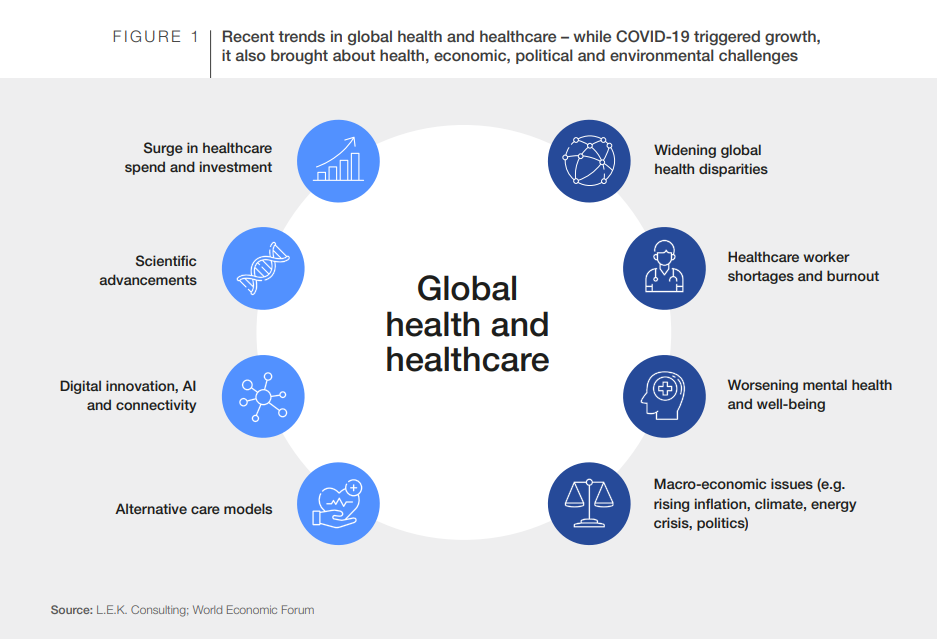HEALTH AND HEALTHCARE
World Health Day: 8 trends shaping global healthcare
Apr 5, 2023
World Health Day: Reshaping our global healthcare systems to cope with its complex and interconnected challenges is a pressing concern.
Image: Pexels/Anna Shvets
Shyam Bishen
Head, Shaping the Future of Health and Healthcare, Member of Executive Committee, World Economic Forum
Share:
OUR IMPACT
What’s the World Economic Forum doing to accelerate action on Health and Healthcare?
THE BIG PICTURE
Explore and monitor how Health and Healthcare is affecting economies, industries and global issues
CROWDSOURCE INNOVATION
Get involved with our crowdsourced digital platform to deliver impact at scale
Stay up to date:
Health and Healthcare
This article is part of:
Shaping the Future of Health and Healthcare
Listen to the article
8 min listen
The pandemic put global healthcare systems to the test and revealed systemic issues and inequalities.
Future healthcare systems will benefit from improved diagnostics and treatment, as well as being assisted by digital tools and AI, a new report from the World Economic Forum points out.
But macro-economic trends, worker well-being and growing inequalities continue to threaten global systems.
The COVID-19 pandemic presented the biggest test our modern global healthcare systems have ever seen. It revealed stark inequalities and systemic issues, leaving many systems scarred and struggling to recover.
But it also demonstrated the effectiveness of new ways of working and digital tools to address some of the challenges faced by the industry. In addition, it allowed for innovation in science and medicines development, distribution and delivery.
The challenges faced by the global health and healthcare sector are set to continue in the future. The near-term issues include worsening mental health, healthcare workforce shortages, supply chain issues, climate change-related challenges and macroeconomic instability. The longer-term challenges include growing demand for services, an increasing funding gap, a lack of incentives for innovation, widening disparities in overall health and wellness, and variable access to advanced therapies.
These challenges are complex and interconnected. Reshaping our healthcare systems to cope with them is a pressing global concern.
This is a key issue tackled in the World Economic Forum’s Global Health and Healthcare Strategic Outlook, which sets out “a shared vision for health and healthcare by 2035”.
World Health Day 2023: Health For All
As we approach World Health Day on 7 April, here are eight current global health and healthcare trends we need to contend with as we aim to transform systems to become more sustainable, resilient and equitable.
A graphic showing recent trends in global health and healthcare. World Health Day
The pandemic triggered both growth and challenges for global healthcare. Image: World Economic Forum.
1. Surging healthcare spend and investment
Global healthcare spend is thought to have grown more than 40% between 2018 and 2022, reaching $12 trillion. At the same time, healthcare investments have also reached record highs in recent years, with attention on areas such as gene immunotherapy and new mRNA vaccines for diseases such as Zika and malaria.
2. Scientific advancements
Alongside this investment, we are also seeing progress in treatments and diagnosis of disease. Precision medicine using biomarkers is increasingly being used, while advancements in liquid biopsies, for example, are changing how cancer is detected.
3. Digital innovation and AI
The pandemic fired rapid digitalization across healthcare, as with other sectors. And in 2021, digital investments in the healthcare sector nearly doubled to $57 billion, with an emphasis on telehealth and mental health. Tech companies are increasingly focusing on healthcare, while digital health start-ups are also growing rapidly.
There is also growing attention being paid to data – better aggregation and analysis is enabling more informed insights and potentially also prediction and disease modelling.
Meanwhile, AI is being used to support areas including diagnosis, clinical decisions, monitoring and treatment, and workflow. AI-assisted medical imaging is already in use, and many drug companies are exploring AI-assisted drug development.
4. Alternative care models
We are increasingly recognizing the importance and power of care provision outside of hospitals, in homes and communities. In fact, growth in expenditure on health provision and care at home is expected to outpace healthcare spend in nearly all other areas. This investment will be used to further home diagnostics, home-administered drug delivery systems and patient monitoring devices, for example.
5. Widening inequalities
The pandemic highlighted significant disparities in healthcare coverage, particularly impacting women, children and adolescents. Low- and middle-income countries were particularly affected by disruptions to essential healthcare services. Future healthcare provision needs to focus on closing these gaps and making healthcare affordable and accessible to all.
6. Healthcare worker shortages and burnout
The pandemic took its toll on healthcare workers, adding to an already stressed and overworked workforce. Mental health issues and burnout worsened, leading to many professionals leaving the sector as well as reduced recruitment. The fall-out from this continues to be felt, and compounding pressures within the system mean the problem is not alleviating for many.
DISCOVER
What is the World Economic Forum doing about mental health?
7. Worsening mental health and well-being
Poor mental health is a worsening issue in society more broadly. Systems have largely underplayed its importance in comparison to physical health, while pent-up demand for support and delays in intervention are exacerbating the problem. Widespread isolation, stress, uncertainty and loss during lockdowns has left its mark on many people.
8. Macro-economic issues
Challenges being played out on the global stage also filter through to our healthcare systems. Geopolitical tensions, soaring energy prices, inflation and supply chain issues all create increasing costs and friction for the healthcare system. Meanwhile, environmental concerns and the climate crisis are exacerbating many health conditions and the prevalence of some diseases, and also creating challenges in relation to the sector’s sustainability.
A graphic showing the vision for health and healthcare is formed of four main strategic pillars.
The World Economic Forum sees equity as the foundation of healthcare in 2035. Image: World Economic Forum.
Transforming healthcare to create a system fit for the challenges it faces now and in the future requires cooperation and strategic partnerships.
As the World Economic Forum lays out in its report, there are four strategic pillars which need to be addressed: equitable access and outcomes; healthcare systems transformation; technology and innovation; and environmental sustainability.
Collectively, these pillars can be used to support systemic, long-term change and build better health and healthcare across the world.
Have you read?
Mental health: lessons learned in 2020 for 2021 and beyond
Davos 2023: What you need to know about the future of global health
How we can transform healthcare by moving from pipeline to platform
Don’t miss any update on this topic
Create a free account and access your personalized content collection with our latest publications and analyses.
License and Republishing
World Economic Forum articles may be republished in accordance with the Creative Commons Attribution-NonCommercial-NoDerivatives 4.0 International Public License, and in accordance with our Terms of Use.
The views expressed in this article are those of the author alone and not the World Economic Forum.
Related topics:






























